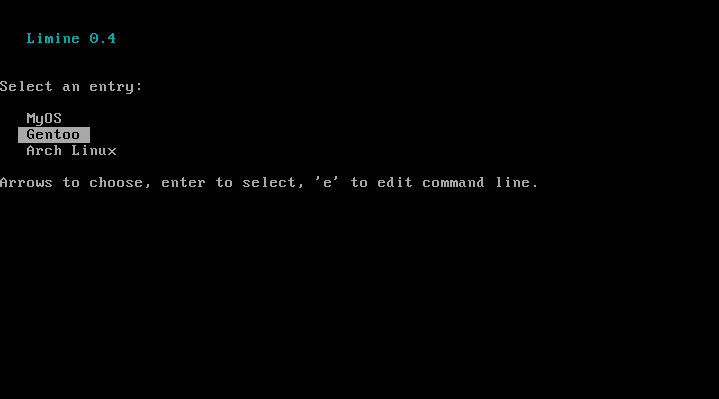| src | ||
| test | ||
| toolchain | ||
| .gitignore | ||
| bochsrc | ||
| CONFIG.md | ||
| LICENSE.md | ||
| limine-install.c | ||
| limine.bin | ||
| Makefile | ||
| README.md | ||
| screenshot.png | ||
| STIVALE2.md | ||
| STIVALE.md | ||
Limine
x86/x86_64 BIOS Bootloader
Supported boot protocols
- Linux
- stivale and stivale2 (Limine's native boot protocols, see STIVALE{,2}.md for details)
Supported filesystems
- ext2
- echfs
- FAT32
Supported partitioning schemes
- MBR
- GPT
How to use
This repository contains a prebuilt version of Limine so building it won't be necessary.
In order to install Limine on a MBR device (which can just be a raw image file), build the
limine-install program using make limine-install, then run the resulting executable as such:
./limine-install ./limine.bin <path to device/image>
If using a GPT formatted device, it will be necessary to create an extra partition (of at least 32K in size) to store stage 2 code. Then it will be necessary to tell the install script where this partition is located by specifying the start sector.
fdisk <device> # Create bootloader partition using your favourite method
./limine-install ./limine.bin <path to device/image> <start sector of boot partition>
Then make sure the device/image contains at least 1 partition formatted in
a supported filesystem containing a /limine.cfg or /boot/limine.cfg file
and the kernel/modules one wants to load.
An example limine.cfg file can be found in test/limine.cfg.
More info on the format of limine.cfg can be found in CONFIG.md.
For example, to create an empty image file of 64MiB in size, 1 echfs partition on the image spanning the whole device, format it, copy the relevant files over, and install Limine, one can do:
dd if=/dev/zero bs=1M count=0 seek=64 of=test.img
parted -s test.img mklabel msdos
parted -s test.img mkpart primary 1 100%
parted -s test.img set 1 boot on # Workaround for buggy BIOSes
echfs-utils -m -p0 test.img quick-format 32768
echfs-utils -m -p0 test.img import path/to/limine.cfg limine.cfg
echfs-utils -m -p0 test.img import path/to/kernel.elf kernel.elf
echfs-utils -m -p0 test.img import <path to file> <path in image>
...
./limine-install $THIS_REPO/limine.bin test.img
One can get echfs-utils by installing https://github.com/qword-os/echfs.
Building from source
In order to hack Limine, one must build the GCC toolchain from source first.
To do so, run the make_toolchain.sh script from within the toolchain directory;
keep in mind that the script takes MAKEFLAGS as an argument.
cd toolchain
./make_toolchain.sh -j4
After that is done, simply run make in the root of the repo to generate
limine.bin.
Building from source with Clang
It is also possible to build Limine with Clang, using the following make command:
make CC="clang --target=i386-elf"
Discord server
We have a Discord server if you need support, info, or you just want to hang out: https://discord.gg/QEeZMz4
